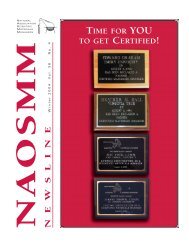Laboratory Safety Guidance
OSHA Lab Safety Guidance - ORS Optical Remote Sensing ...
OSHA Lab Safety Guidance - ORS Optical Remote Sensing ...
- No tags were found...
Create successful ePaper yourself
Turn your PDF publications into a flip-book with our unique Google optimized e-Paper software.
29 CFR 1910.1200(f)(4). Labels on chemical containers<br />
must not be removed or defaced.<br />
Material <strong>Safety</strong> Data Sheets (MSDSs) for chemicals<br />
received by the laboratory must be supplied by the<br />
manufacturer, distributor, or importer and must be<br />
maintained and readily accessible to laboratory<br />
workers. MSDSs are written or printed materials<br />
concerning a hazardous chemical. Employers must<br />
have an MSDS in the workplace for each hazardous<br />
chemical in use.<br />
MSDS sheets must contain:<br />
1. Name of the chemical;<br />
2. Manufacturer’s information;<br />
3. Hazardous ingredients/identity information;<br />
4. Physical/chemical characteristics;<br />
5. Fire and explosion hazard data;<br />
6. Reactivity data;<br />
7. Health hazard data;<br />
8. Precautions for safe handling and use; and<br />
9. Control measures.<br />
The United States is participating in the Global<br />
Harmonization System of Classifying and Labeling<br />
Chemicals (GHS) process and is planning to adopt<br />
the GHS in its Hazard Communication standard.<br />
The GHS process is designed to improve comprehensibility,<br />
and thus the effectiveness of the Hazard<br />
Communication standard (HCS), and help to further<br />
reduce illnesses and injuries. GHS is a system that<br />
defines and classifies the hazards of chemical products,<br />
and communicates health and safety information<br />
on labels and material safety data sheets<br />
(called <strong>Safety</strong> Data Sheets, or SDSs, in the GHS).<br />
The most significant changes to the Hazard<br />
Communication standard will include changing terminology:<br />
“hazard determination” to “hazard classification”<br />
(along with related terms) and “material<br />
safety data sheet” to “safety data sheet.” The goal<br />
is that the same set of rules for classifying hazards,<br />
and the same format and content for labels and<br />
safety data sheets (SDS) will be adopted and used<br />
around the world. An international team of hazard<br />
communication experts developed GHS.<br />
The biggest visible impact of the GHS is the<br />
appearance of and information required for labels<br />
and SDSs. Labels will require signal words, pictograms,<br />
precautionary statements and appropriate<br />
hazard statements. The GHS system covers all hazardous<br />
chemicals and may be adopted to cover<br />
chemicals in the workplace, transport, consumer<br />
products, and pesticides. SDSs will follow a new<br />
16-section format, containing requirements similar<br />
to those identified in the American National<br />
Standards Institute (ANSI) Z400 and International<br />
Organization for Standardization (ISO) 11014 standards.<br />
Information on GHS classification, labels and<br />
SDSs is available at: http://www.unece.org/<br />
trans/danger/publi/ghs/ghs_welcome_e.html.<br />
Chemical Hygiene Plan (CHP)<br />
The purpose of the CHP is to provide guidelines for<br />
prudent practices and procedures for the use of<br />
chemicals in the laboratory. The <strong>Laboratory</strong> standard<br />
requires that the CHP set forth procedures,<br />
equipment, PPE and work practices capable of protecting<br />
workers from the health hazards presented<br />
by chemicals used in the laboratory.<br />
The following information must be included in each<br />
CHP:<br />
Standard Operating Procedures (SOPs): Prudent<br />
laboratory practices which must be followed when<br />
working with chemicals in a laboratory. These<br />
include general and laboratory-specific procedures<br />
for work with hazardous chemicals.<br />
Criteria for Exposure Control Measures: Criteria<br />
used by the employer to determine and implement<br />
control measures to reduce worker exposure to<br />
hazardous chemicals including engineering controls,<br />
the use of PPE and hygiene practices.<br />
Adequacy and Proper Functioning of Fume Hoods<br />
and other Protective Equipment: Specific measures<br />
that must be taken to ensure proper and adequate<br />
performance of protective equipment, such as fume<br />
hoods.<br />
Information and Training: The employer must provide<br />
information and training required to ensure<br />
that workers are apprised of the hazards of chemicals<br />
in their work areas and related information.<br />
Requirement of Prior Approval of <strong>Laboratory</strong><br />
Procedures: The circumstances under which certain<br />
laboratory procedures or activities require approval<br />
from the employer or employer’s designee before<br />
work is initiated.<br />
Medical Consultations and Examinations:<br />
Provisions for medical consultation and examination<br />
when exposure to a hazardous chemical has or<br />
may have taken place.<br />
1 0<br />
Occupational <strong>Safety</strong> and<br />
Health Administration



